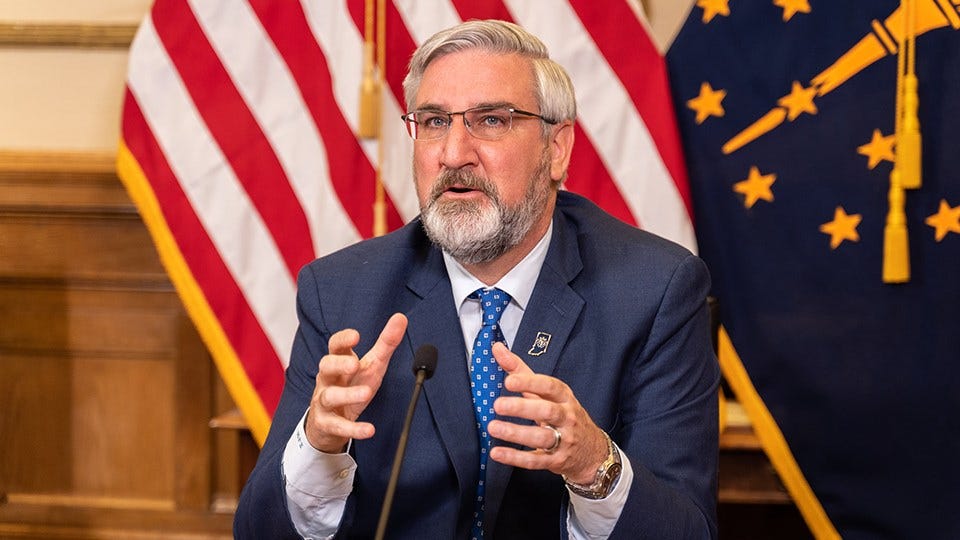Holcomb: Midwest Collaboration is Commitment to EV Future
Subscriber Benefit
As a subscriber you can listen to articles at work, in the car, or while you work out. Subscribe Now
Governor Eric Holcomb has joined his counterparts in Illinois, Michigan, Minnesota and Wisconsin in a collaboration to boost electric vehicle charging infrastructure throughout the Midwest. The governors last fall signed a Regional Electric Vehicle for the Midwest Memorandum of Understanding with the goal of accelerating vehicle electrification. “We’re the Crossroads of America and we want to be the Smart Crossroads of America,” said Holcomb. “And to do that, you have to obviously know your environment and that means your neighbors.”
Holcomb says it is imperative for states in the Midwest “to get this right.”
“The global goals are to go even more EV,” the governor said. “We make things here. We ship things here. But, we have to be part of the create things here, too, the research and development phase because after all, it’s right in our backyard. This is the lab. This is where you go to see if it works or not and Indiana’s front and center and in this discussion and we are thankful and applaud our federal partners for placing an emphasis on this as well.”
Holcomb’s office says REV Midwest will provide a foundation for cooperation on fleet electrification along key commercial corridors. The collaboration aims to help safeguard economic security, add jobs, futureproof interstate commerce, reduce emissions, and advance innovation.
Additionally, the governor’s office says the MOU will ensure the region is able to compete for new private investment and federal funding for vehicle electrification.
While the specifics of what each state will contribute to the effort are still being ironed out, Holcomb says the bottom line of the entire project is more opportunities for Hoosiers in terms of careers, with an estimated 105,000 new jobs expected to be needed to deploy EV charging infrastructure by 2030.
“What this conversation means is there’s another huge transition occurring like in so many other spaces,” he said. “Some may deny that transition at their own peril; some may embrace it and resolve themselves to lead it and that’s what Indiana is doing.”
The partnering states say the MOU will also competitively position the region for economic development growth surrounding electric vehicles, EV charging infrastructure, battery performance and other technologies.
“We shouldn’t have to choose between building a cleaner, more equitable state and economic development—and thankfully, vehicle electrification is an area where we can do both,” Wisconsin Governor Tony Evers said in written remarks. “This regional partnership will be critical for addressing emissions from the transportation sector, ensuring folks in every community have cleaner air to breathe, and creating jobs to meet our future workforce needs.”
Indiana has already begun seeing such a transition. In October, automaker Stellantis announced plans to invest $230 million to retool three of its plants in Kokomo to manufacture its fourth-generation eight-speed transmission, which could be used with mild hybrid and plug-in hybrid propulsion systems, in addition to traditional combustion engines.
The Hoosier State was also being considered for a major EV battery manufacturing plant from Toyota, though that investment ultimately went to North Carolina.
“What [this effort] means at the end of the day is 20, 30, 40 years from now, Kokomo, Indiana remains a vibrant community because of the decisions and investments and commitments that we’re making in 2021, 22, 23, 24, 25 that gets to the industry’s goals of 2050 and 2060 because we have the wherewithal and the will to be thinking about playing offense…and that’s going to serve us well down the road,” Holcomb said.
You can read the full MOU by clicking here.
Editor’s Note: This story first appeared in the December edition of our quarterly INPower e-newsletter. You can subscribe to the newsletter here.
Holcomb says it is imperative for states in the Midwest “to get this right.”
Holcomb says the bottom line of the project is more career opportunities for Hoosiers.
